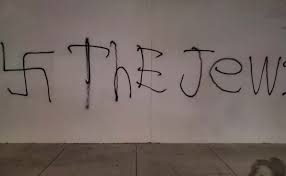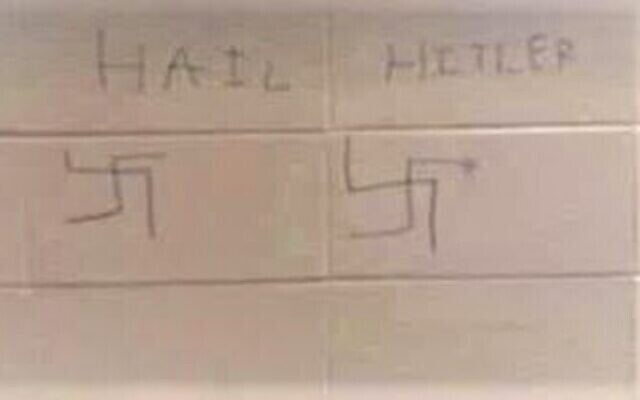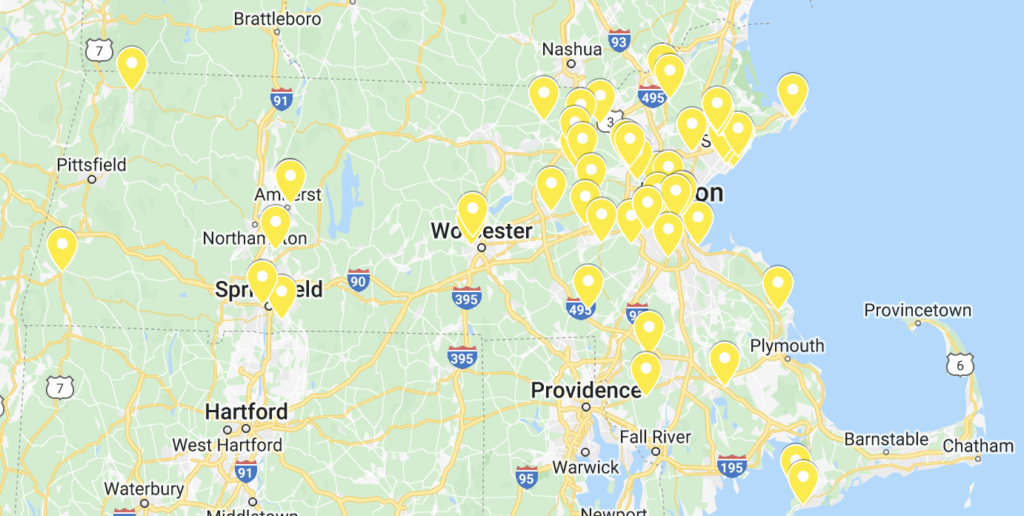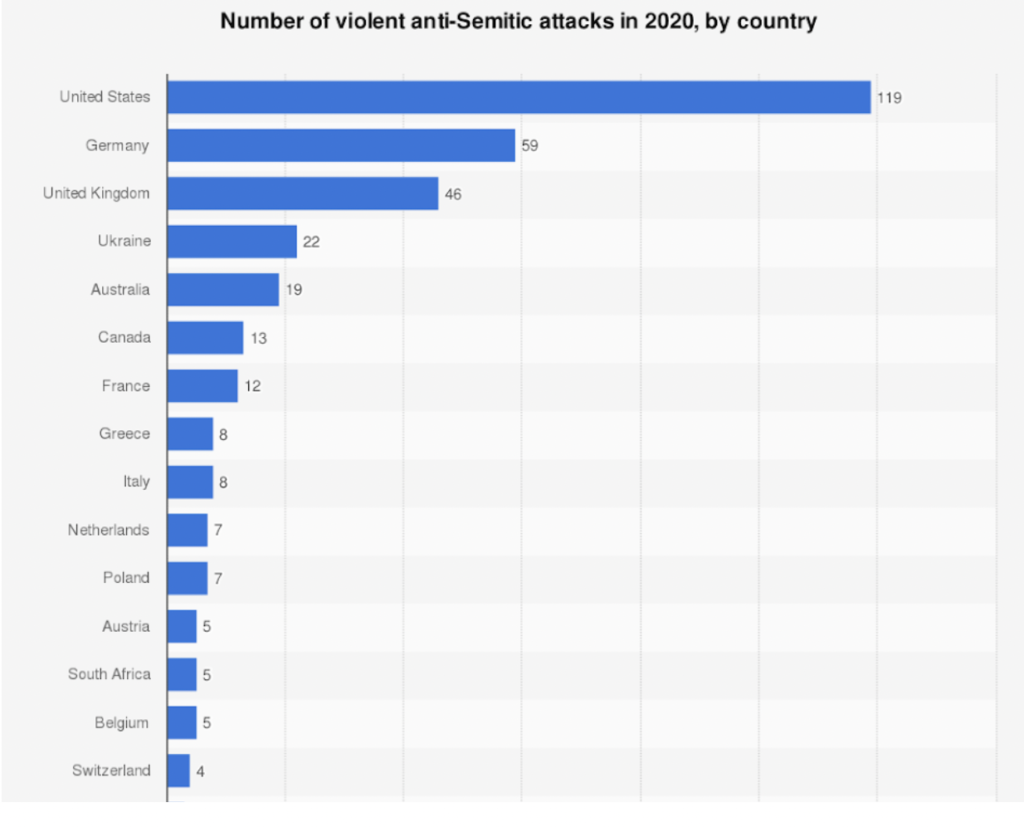


Antisemetic images are not what anyone expects to find scribbled in an elementary school bathroom in a quaint, seaside town just 16 miles north of Boston. But this past January 18th, and again on January 26th, this is exactly what students discovered inside two boys’ bathrooms at Village School in Marblehead, Massachusetts. Then, on January 28th, the day after International Holocaust Remembrance Day, “[Expletive] the Jews” was found on a girls’ bathroom stall (Luca, 2022). I grew up Jewish in Marblehead. This is not the Village School I know and attended.

Yet these are not isolated incidents. In March 2020, a white supremacist revealed his swastika tattoo during a webinar on antisemitism that was attended by several Marblehead students (Anti-Defamation League, 2020). In 2021, vandals defaced several beloved public spaces – Crocker Park, Ware Pond, and a mural on the Marblehead Rail Trail – with antisemetic graffiti (Forman, 2021). In the same year, a Marblehead police officer etched an antisemetic image onto a fellow officer’s cruiser (Forman, 2021). And as recently as March 2022, two fourth grade students happened upon another swastika, this time in a bathroom at Tower School, a private school just down the street from Village School (Rosenberg, 2022)

Unfortunately, what is happening in Marblehead is happening across Massachusetts. In 2019, an arsonist targeted two Chabad Jewish Centers and a Jewish-affiliated business in Arlington and Needham. Prior to the events, the suspected arsonist had written several antisemetic statements including, “We must kill all the Jews” (Shalev, 2022). In 2020, 36-year-old John Michael Rathburn unsuccessfully tried to detonate a homemade explosive near the entrance of a Longmeadow Jewish assisted living facility in proximity to three synagogues, a Jewish private school, and a Jewish community center (United States Department of Justice, 2020). And last year, citizens were shocked to learn the Duxbury High School football team has been using antisemetic slurs for play calls for at least the past decade (Dwinell, 2021). These are just a few of the more than 75 antisemetic incidents that have occurred in Massachusetts during the past three years (Anti-Defamation League, 2022).
Antisemitism is increasing nationwide. A 2014 study of approximately 4,000 Jewish American adults found that nearly one-fourth (24%) had experienced antisemitism within the past year (Rebhun, 2014: 44-60). This suggests that, here in the U.S., contemporary Jewish adults are more likely than not to be confronted by antisemitism during their lifetime.
Not only have antisemetic incidents increased by an average of 522 incidents per year from 2015 to 2017, but the severity is growing. Although the total number of incidents decreased slightly from 1,986 in 2017 to 1,879 in 2018, there were 71 more harassment and assault incidents during that same time period, indicating that antisemitism is trending more physical and violent. In fact, in 2020, the United States led the world with 119 violent antisemetic incidents – more incidents than the next two countries, Germany and the United Kingdom, combined (Alexander and Naamat, 2021). Given these figures, it’s not surprising that many Jewish people have become increasingly concerned for their safety in recent years (Wright et al. 2021).
Notably, the majority of antisemetic incidents in the United States occur at places and institutions typically considered to be safe havens. Each time these safe havens are desecrated, the Jews in these communities don’t view these occurrences as “outliers or isolated incidents, but as harbingers of future violence” (Wright et al. 2021). They feel unsafe. Consequently, some Jews may begin to feel less connected to their own local community, a notion supported by a 2011 study which found that being targeted by antisemitism had the potential to make Jews feel like outsiders (Alper & Olson, 2011: 823). Antisemitism may prompt some Jews to disassociate themselves from their religious identity, similar to what many of American Jews did during antisemitism’s peak in the 1930s (Dean, 1955). This notion is supported by the American Jewish Committee’s 2021 survey of Jewish adults. Of the 1,433 Jews surveyed, nearly one in four respondents indicated fear of antisemitism has prevented them from identifying themselves as Jewish (America Jewish Committee, 2021). Thus, if antisemitism continues to grow unchecked, Jews may, indeed, become more and more alienated, not just from from their local communities, but from Judaism itself.
References
Alexander, Michael and Talia Naamat. 2021. “Antisemitism Worldwide 2020.” Kantor Center. Retrieved March 9, 2022 (https://en-humanities.tau.ac.il/sites/humanities_en.tau.ac.il/files/medi a_server/Antisemitism%20Wo rldwide%202020.pdf).
Alper, Becka A., and Daniel V.A. Olson. 2011. “Do Jews Feel Like Outsiders in America? The Impact of Anti-Semitism, Friendships, and Religious Geography.” Journal for the Scientific Study of Religion. 50(4):822-830.
American Jewish Committee. 2021. “The State of Antisemitism in America 2021: AJC’s Survey of American Jews.” American Jewish Committee. Retrieved March 28, 2022 (https://www.ajc.org/AntisemitismReport2021/AmericanJews).
Anti-Defamation League 2022. “ADL Tracker of Antisemetic Incidents.” Anti-Defamation League. Retrieved March 29, 2022. (https://www.adl.org/education-and-resources/resource-knowledge-base/adl-tracker-of-antisemitic-incidents?field_incident_location_state_target_id=4807&page=7).
Anti-Defamation League 2020. “What is “Zoombombing” and Who is Behind It?” Anti-Defamation League. Retrieved March 9, 2022 (https://www.adl.org/blog/what-is-zoombombing-and-who-is-behind-it).
Dean, John P.. 1955. “Impact of Antisemitism: Comment on John P. Dean’s “Patterns of Socialization and Association between Jews and Non-Jews.” Jewish Social Studies. 17(3):275-278.
Dwinell, Joe. 2021. “Duxbury’s fired football coach explains ‘origins’ of anti-Semitic slurs.” Boston Herald. (https://www.bostonherald.com/2021/06/11/duxburys-fired-football-coach-explains-origins-of-anti-semitic-slurs/).
Foreman, Ethan M.. 2021. “Marblehead residents want answers on alleged antisemitic incident involving police officer.” Jewish Journal. (https://jewishjournal.org/2021/07/01/marblehead-residents-want-answers-on-alleged-antisemitic-incident-involving-police-officer/).
Foreman, Ethan M.. 2021. “Police say three incidents of hate graffiti in Marblehead over the weekend may be related.” Jewish Journal. (https://jewishjournal.org/2021/05/07/police-say-three-incidents-of-hate-graffiti-in-marblehead-over-the-weekend-may-be-related/).
Luca, Dustin. 2022. “Antisemitic incidents rocks Marblehead’s Village School.” The Salem News. (https://www.salemnews.com/news/antisemitic-incidents-rocks-marbleheads-village-school/article_59d27c42-8461-11ec-a029-835a1eec2368.html).
Rebhun, Uzi. 2014. “Correlates of experiences and perceptions of anti-Semitism among Jews in the United States.” Social Science Research 47(1):44-60. https://doi.org/10.1016/j.ssresearch.2014.03.007.
Rosenberg, Steven A.. 2022. “In Marblehead, swastika discovered at Tower School..” Jewish Journal. (https://jewishjournal.org/2022/03/25/in-marblehead-swastika-discovered-at-the-tower-school/).
Shalev, Asaf. 2022. “FBI was investigating alleged Massachusetts synagogue arsonist at the time of the fires.” Jewish Telegraph Agency. (https://www.jta.org/2022/02/16/united-states/fbi-was-investigating-alleged-massachusetts-synagogue-arsonist-at-the-time-of-the-fires).
Statista. 2019. “Anti-Semitic Incidents Grow More Serious in the U.S..” Statista. Retrieved March 9, 2022. (https://www.statista.com/chart/9128/anti-semitic-incidents-are-surging-in-the-us/).
United States Department of Justice. 2020. “East Longmeadow Man Charged with Attempted Arson at Longmeadow Assisted Living Residential Facility.” United States Department of Justice. Retrieved March 9, 2022 (https://www.justice.gov/usao-ma/pr/east-longmeadow-man-charged-attempted-arson-longmeadow-assisted-living-residential).
Wright, Graham, Sasha Volodarsky, Shahar Hecht, and Leonard Saxe. 2021. “Trends in Jewish Young Adult Experiences and Perceptions of Antisemitism in America from 2017 to 2019.” Contemporary Jewry. 41(2): 461-481. https://www.proquest.com/scholarly-journals/trends-jewish-young-adult-experiences-perceptions/docview/2602864259/se-2, doi:http://dx.doi.org/10.1007/s12397-021-09354-6.

